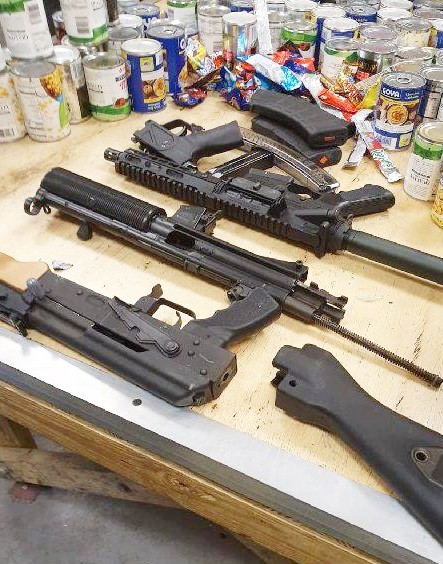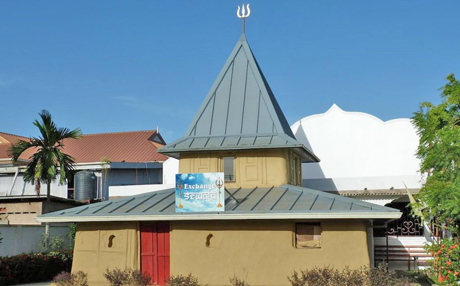
Port of Spain – Three assault rifles, including an AR-15 and an AK-47, were discovered on the port of Port of Spain on Monday hidden in a barrel stocked with canned meats and vegetables.
Police are searching for a man who attempted to retrieve the barrel but after the rifles along with three magazines and an assortment of ammunition plus a Glock pistol were found he ran from the port into Port of Spain and disappeared.
Police confirmed that sometime on Monday the man arrived to clear the barrel.
It was stocked with cans of beans, mixed vegetables and meat along with packs of Ramen noodles and pasta. As Customs and Excise (C&E) officers dug deeper, however, they discovered the three rifles packed beneath the food. Stashed beneath the rifles were the magazines and the handgun. When they were about to confront the man about the find he ran out of the office.
Police officers of the Organised Crime, Narcotics and Firearms Bureau were called in and the items were handed over.
A meeting of the Joint Select Committee on the prevalence of illegal firearms in Trinidad and Tobago showed that although scanners at the Port of Spain port were active since October 2018, no illegal firearms had been found up to February 2019.
Comptroller of C&E, Vidyah Marcial, said there were no findings of narcotics or weapons but that an upgrade to the system was pending, along with additional training for staff.
Police are searching for a man who attempted to retrieve the barrel but after the rifles along with three magazines and an assortment of ammunition plus a Glock pistol were found he ran from the port into Port of Spain and disappeared.
Police confirmed that sometime on Monday the man arrived to clear the barrel.
It was stocked with cans of beans, mixed vegetables and meat along with packs of Ramen noodles and pasta. As Customs and Excise (C&E) officers dug deeper, however, they discovered the three rifles packed beneath the food. Stashed beneath the rifles were the magazines and the handgun. When they were about to confront the man about the find he ran out of the office.
Police officers of the Organised Crime, Narcotics and Firearms Bureau were called in and the items were handed over.
A meeting of the Joint Select Committee on the prevalence of illegal firearms in Trinidad and Tobago showed that although scanners at the Port of Spain port were active since October 2018, no illegal firearms had been found up to February 2019.
Comptroller of C&E, Vidyah Marcial, said there were no findings of narcotics or weapons but that an upgrade to the system was pending, along with additional training for staff.
National Heritage Trust
Trinidad urges the authorities

By Paras Ramoutar
Scores of devotees who worship at the Exchange, Couva Mandir want the 145- year old structure be declared a National Heritage Trust and a Tourism Spot.
This year, 2019, marks the 174th year of the arrival of East Indians from India, principally Uttar Pradesh and Bihar, to work on the enhancement of agricultural development, principally sugar cane and cocoa.
“This Lord Shiva Mandir (called in the early days Lord Shiva Kutia or Lord Shiva Sewala) has a very chequered history with the arrival, growth and empowerment of the East Indians in Trinidad and Tobago between the years 1845 and 1917,” Pundit Hardeo Maharaj, the curator noted.
Today, after 145 years (circa) the original structure remains intact as the tapia-and-dirt building reflects on the East Indian presence here because it was the cheapest form of material for construction. It was covered with grass, and adjoining was a marro (shed) which was used as a discussion centre and everyone sat on the ground. Here still exists the large hole, in the middle, a somewhat sunken basement which was used for prayer and meditation. On the altar, sits the pantheon of Hindu gods and goddesses, overshadowed by Lord Shiva, in whose name the Mandir was built.
Scores of devotees who worship at the Exchange, Couva Mandir want the 145- year old structure be declared a National Heritage Trust and a Tourism Spot.
This year, 2019, marks the 174th year of the arrival of East Indians from India, principally Uttar Pradesh and Bihar, to work on the enhancement of agricultural development, principally sugar cane and cocoa.
“This Lord Shiva Mandir (called in the early days Lord Shiva Kutia or Lord Shiva Sewala) has a very chequered history with the arrival, growth and empowerment of the East Indians in Trinidad and Tobago between the years 1845 and 1917,” Pundit Hardeo Maharaj, the curator noted.
Today, after 145 years (circa) the original structure remains intact as the tapia-and-dirt building reflects on the East Indian presence here because it was the cheapest form of material for construction. It was covered with grass, and adjoining was a marro (shed) which was used as a discussion centre and everyone sat on the ground. Here still exists the large hole, in the middle, a somewhat sunken basement which was used for prayer and meditation. On the altar, sits the pantheon of Hindu gods and goddesses, overshadowed by Lord Shiva, in whose name the Mandir was built.

From the limited available data, historical evidence and word of mouth from our forefathers, the Exchange Mandir is probably the oldest such institution in Trinidad and Tobago, as it could well be the emblem of the East Indian presence.
Ornamenting the wall is an undated photograph with four East Indian labourers dressed in the traditional East Indian wear – dhoti and merrino.
Pundit Maharaj maintains very close contact with psychiatrist, Dr Rampersad Parasram and international journalist, Jai Parasram of the famous Hindu religious Parasram family of McBean, Couva.
“When the East Indians, some 148,000, came here they were brought here by the then colonial government to rescue agriculture, and they brought with them their rich cultural, religious, social and philosophical stocks which remain as part of the national culture and heritage of the nation-state of Trinidad and Tobago,” Pundit Mahraj underlined.
They came here after slavery was ended by the British Parliament in 1834. After the blacks were freed, Portugese and Chinese labourers were brought in, but they exited the cane fields and the East Indians were brought in and today they continue to make both a tremendous contribution to the socio-economic, cultural and entrepreneurial progress and growth and development of Trinidad and Tobago.
“As far as my research goes, whilst the Mandir was principally designed for religious activities, it was used as a meeting place to discuss social, economic and political issues of the day as well.
“It was also used to celebrate high point Hindu observances like Divali, Nau Raatri, Shiva Raatri, Ram Nawmi among others. They used to feel that they were in Ajodhya where Lord Rama, who is the main focus of the Hindu holy book, the Ramayana resided. Every time they assembled, it was a moment of nostalgia…back home in India.
”This Mandir was used as the model for the first Divali Nagar in 1986 when all Indian diasporic items, structures, utensils and the like were displayed,” Pundit Maharaj noted.
“Up until the beginning of the 20th century Indian labourers from Claxton Bay, McBean, Freeport, Couva, Indian Trail and other outlying communities used to come with the Port-of-Spain to San Fernando train and stop off at Couva and spend several days to mark the major religious festivals. The Mandir was also used as a marketplace as flowers, puja materials, Indian delicacies were on sale there,” Pundit Maharaj said.
Adjacent to the mandir, existed a pond with ever flowing water in which all devotees had to shower before entering as the Pujari Rohan Gir Gosyne insisted.
Pundit Maharaj noted that scores of insignificant buildings and projects were indentified for possible declaration as National Heritage icons, and although several government ministers visited it “nothing has come out of their visits so far.”
“This particular Mandir needs serious recognition as both a National Heritage Trust and as well a Tourism Spot because it reflects an integral part of our own historical development and in our existence in the cosmos,” Pundit Maharaj said.
And in the midst of the sprawling housing developments and the bustling commercial centre of Couva on the other side, the Exchange Mandir continues to exude an aura of spirituality as a sanctuary for peace and order.
Ornamenting the wall is an undated photograph with four East Indian labourers dressed in the traditional East Indian wear – dhoti and merrino.
Pundit Maharaj maintains very close contact with psychiatrist, Dr Rampersad Parasram and international journalist, Jai Parasram of the famous Hindu religious Parasram family of McBean, Couva.
“When the East Indians, some 148,000, came here they were brought here by the then colonial government to rescue agriculture, and they brought with them their rich cultural, religious, social and philosophical stocks which remain as part of the national culture and heritage of the nation-state of Trinidad and Tobago,” Pundit Mahraj underlined.
They came here after slavery was ended by the British Parliament in 1834. After the blacks were freed, Portugese and Chinese labourers were brought in, but they exited the cane fields and the East Indians were brought in and today they continue to make both a tremendous contribution to the socio-economic, cultural and entrepreneurial progress and growth and development of Trinidad and Tobago.
“As far as my research goes, whilst the Mandir was principally designed for religious activities, it was used as a meeting place to discuss social, economic and political issues of the day as well.
“It was also used to celebrate high point Hindu observances like Divali, Nau Raatri, Shiva Raatri, Ram Nawmi among others. They used to feel that they were in Ajodhya where Lord Rama, who is the main focus of the Hindu holy book, the Ramayana resided. Every time they assembled, it was a moment of nostalgia…back home in India.
”This Mandir was used as the model for the first Divali Nagar in 1986 when all Indian diasporic items, structures, utensils and the like were displayed,” Pundit Maharaj noted.
“Up until the beginning of the 20th century Indian labourers from Claxton Bay, McBean, Freeport, Couva, Indian Trail and other outlying communities used to come with the Port-of-Spain to San Fernando train and stop off at Couva and spend several days to mark the major religious festivals. The Mandir was also used as a marketplace as flowers, puja materials, Indian delicacies were on sale there,” Pundit Maharaj said.
Adjacent to the mandir, existed a pond with ever flowing water in which all devotees had to shower before entering as the Pujari Rohan Gir Gosyne insisted.
Pundit Maharaj noted that scores of insignificant buildings and projects were indentified for possible declaration as National Heritage icons, and although several government ministers visited it “nothing has come out of their visits so far.”
“This particular Mandir needs serious recognition as both a National Heritage Trust and as well a Tourism Spot because it reflects an integral part of our own historical development and in our existence in the cosmos,” Pundit Maharaj said.
And in the midst of the sprawling housing developments and the bustling commercial centre of Couva on the other side, the Exchange Mandir continues to exude an aura of spirituality as a sanctuary for peace and order.


